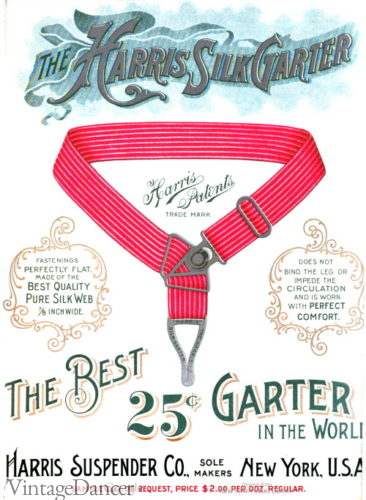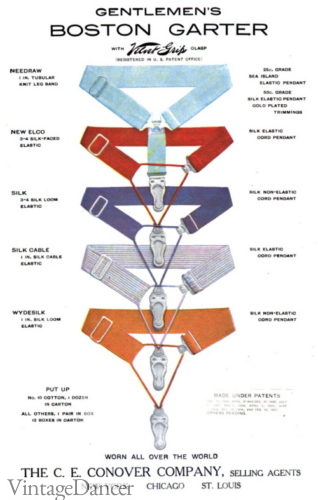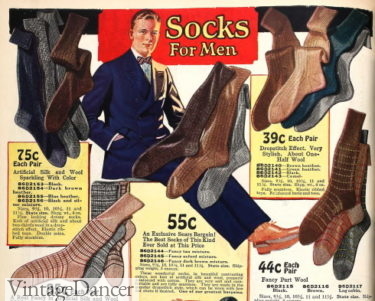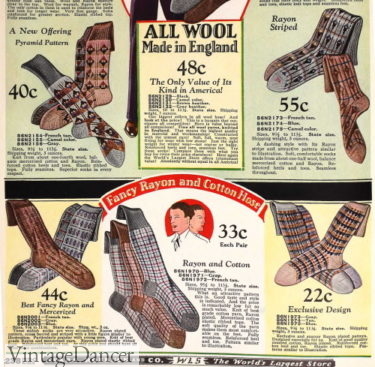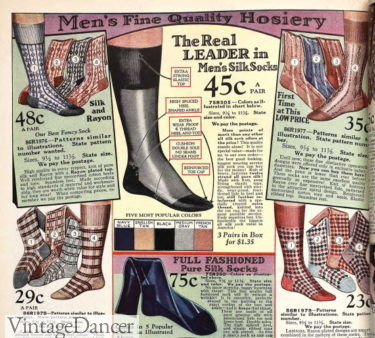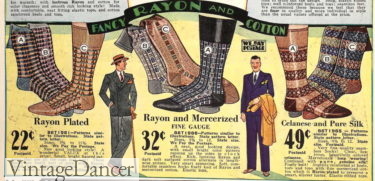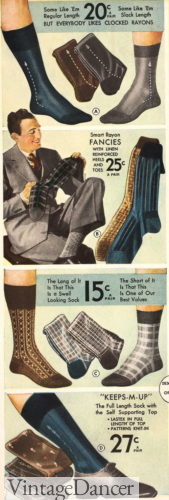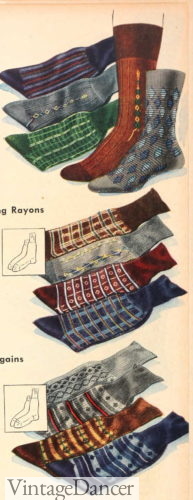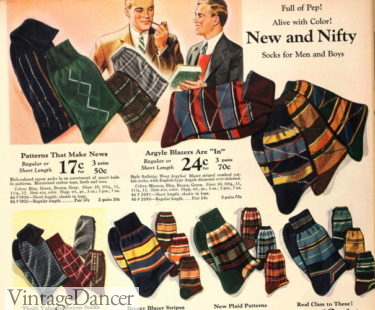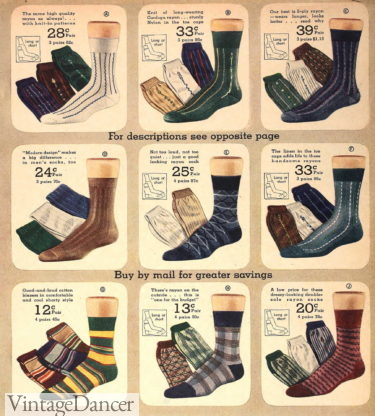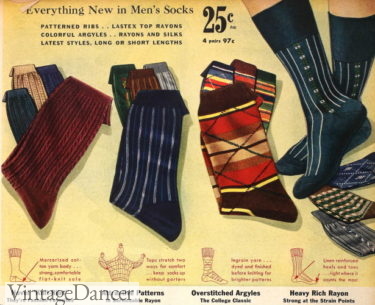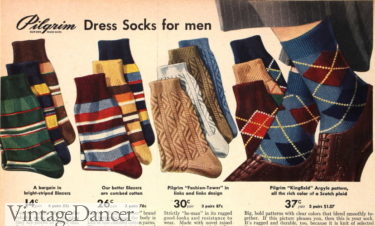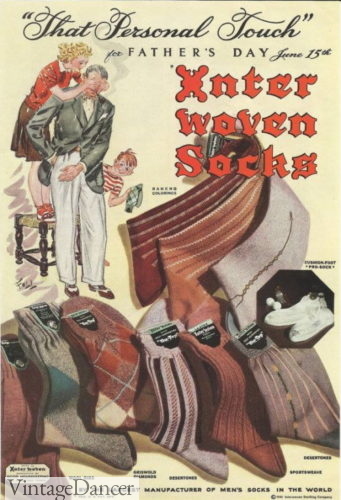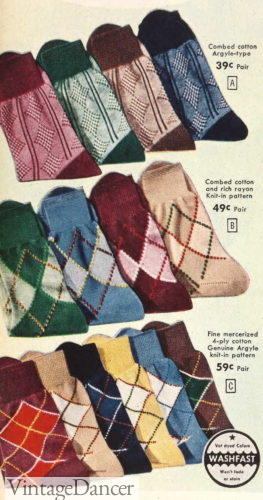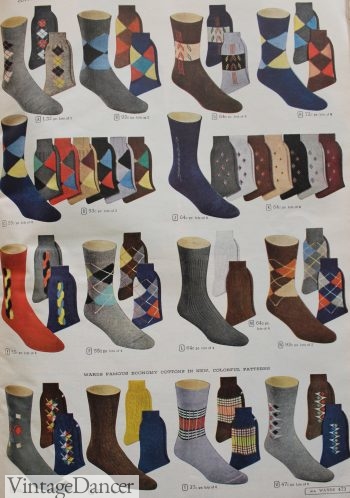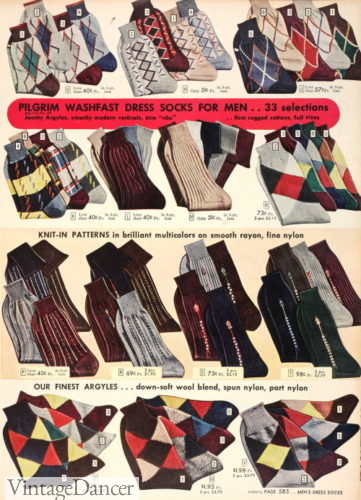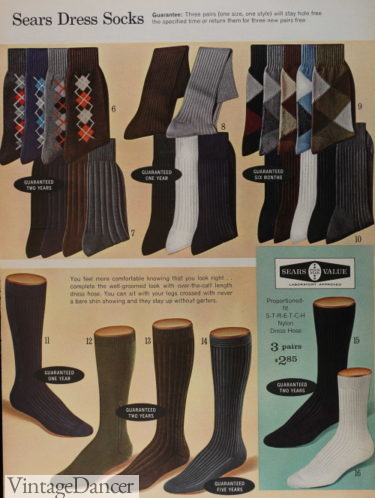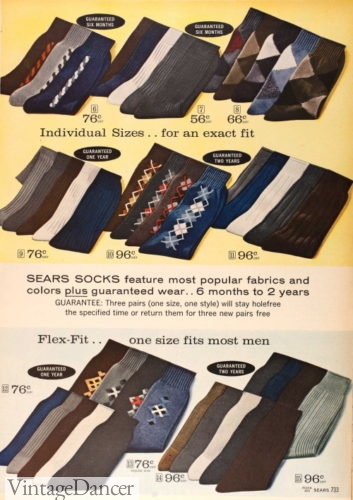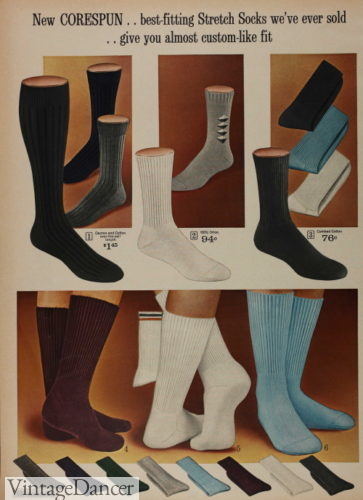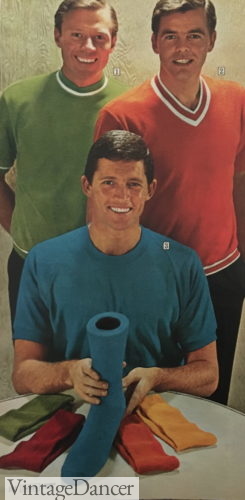Given that men’s socks have only slightly changed since the turn of the early twentieth century, you could be forgiven for underestimating the humble sock. However, here at Vintage Dancer, we find the history of sock hosiery to be rich and interesting. Read on as we unravel everyone’s favorite foot warmers and find out some fun facts about vintage men’s socks.
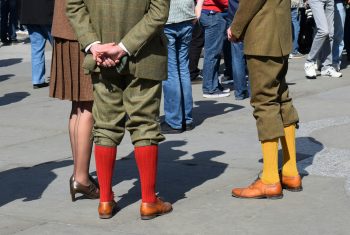
2015 London Tweed Run- Look at Those Fun Socks!
Unsurprisingly, socks date back to the early days of man first getting cold feet.
Did you know that when Howard Carter and his team opened up Tutankhamun’s tomb in 1922, that as well as discovering all the gold and precious stones, they also salvaged several pairs of linen socks? No doubt poised and ready to protect the young king’s feet in the afterlife. These socks date to 1323 BC – I wonder how smelly they are now.
For the purposes of this article, we’re going to focus on the decades that we love so much, namely the 1900s to the 1960s.
1900-1910s Men’s Vintage Socks
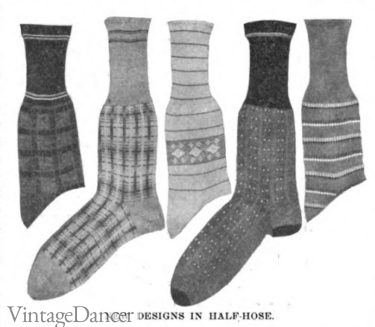
1905 Men’s Half-Hose Socks
Modern socks are so cheap and readily available, sold in multi-packs for a few dollar bills, that when holes appear or a pair cannot be matched, they are quickly disposed of.
That wasn’t the case in the 1900s, where owners took great care to keep their socks clean, in pairs, and in good condition. If a hole started to appear, out would come the needle and thread to swiftly repair them.
At the beginning of the twentieth century, socks were usually black and much longer than they are generally available today. Black socks made sense in a world of dirt and limited bathing facilities. Grey was an alternative color.
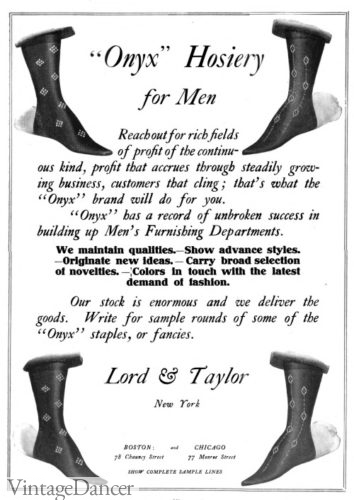
1907 Black Socks
Bearing in mind that central heating was but a distant dream, people wrapped up to keep warm as they sat around a roaring coal fire with a flannel blanket or two. As feet are most prone to getting cold, wool socks were ideal for keeping them lovely and warm. In extreme conditions, feet were vulnerable to frostbite. If left untreated, not only would you most likely lose toes, but it could develop into gangrene, which could be fatal. So, the humble sock could quite literally save your life. We told you they were important.
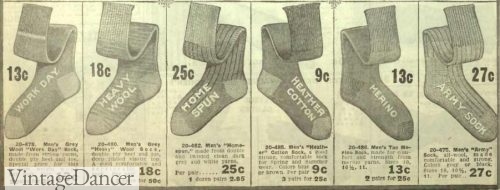
1913, Men’s Wool Socks with Contrasting Heels and Ribbed Tops. Thicker Socks for Workwear, Thin Socks for Home
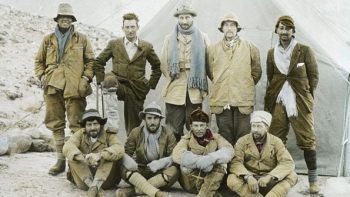
Climbing Mt Everest with George Mallory- Dressed in Layers of Tall Wool Socks
Wool socks were the preferred choice for explorers and mountaineers. When the body of George Mallory was found on Everest 75 years after his disappearance in 1924, he was wearing three pairs of wool socks. It’s since been proven by academics that Mallory’s clothing was warm enough for climbing conditions and perhaps even an improvement on modern options. So although Mallory sadly met his maker up on Everest, his socks weren’t to blame for his untimely demise.
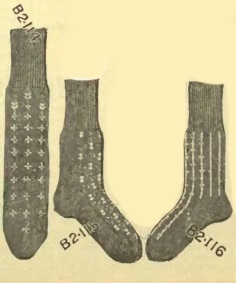
1906 Men’s Dress Socks Made of Cashmere in Embroidered Stripes of Red, Blue, and White
In addition to wool, socks they were also available in other materials such as cashmere, cotton lisle, and silk. They could be smooth or ribbed. When debris from the RMS Titanic was recovered following the ship’s sinking in 1912, a suitcase was opened up to reveal neatly folded clothes, including a pair of unworn socks made from finely knitted black silk.
Colors and patterns started to grow more vibrant into the 1910s. This was due to advances in high-speed knitting technology which led to various patterns, constructions, and colors.

1910 Men’s Socks
As socks were not elasticized like modern examples available so freely at the likes of Target, men were at risk of having their socks sag to reveal bare ankles. To prevent this, gentlemen pulled their socks up which they secured with sock garters (also known as ‘hose garters’). Made of leather or striped elastic, the garter clipped to the end of the sock and fastened around the upper calf. Colors were very vibrant.
- 1901 Men’s Red Sock Garter
- 1908 Colorful Men’s Sock Garters
For working classes, the lumberman’s socks had a drawstring cord at the top (they look like Christmas stockings!).
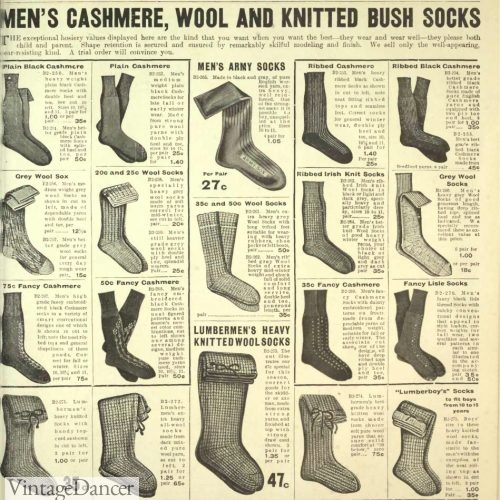
1909 Working Class Heavy-Knit “Lumberman’s” Socks and Fine Silk and Cashmere Dress Socks
1920s Men’s Socks
Moving into the roaring 1920s and after being hidden away for so long, socks began to take center stage. The progress in sock manufacturing meant that more men were now experimenting with patterned colors including blue, brown, tan, and grey. This was no longer just about socks merely being practical and keeping your toes intact. They were beginning to be a way for men to express their own unique style.
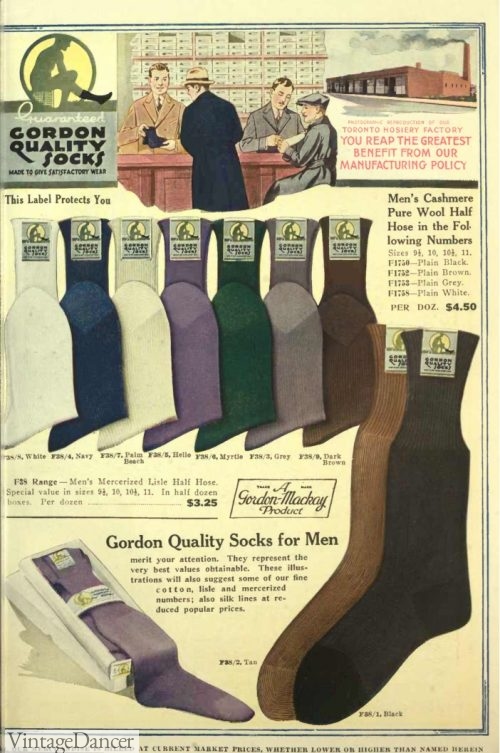
1922 Plain Men’s Dress Socks
We have a British monarch, the Duke of Windsor, to thank for helping to make diamond-patterned argyle socks acceptable wear for the upper and middle classes. As the Duke himself explained, “My favourite sport became golf, and here I found more scope for indulging my freedom of taste in dress.”
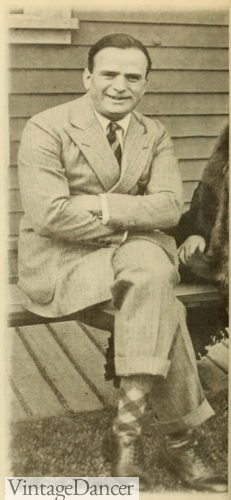
1919 – Great Socks!
However, these long loud socks were only for leisurewear, specifically golf, when they were teamed with plus fours (a type of pants at knee-length) and bold knit sweaters. In these sporting situations of the 1920s, men wore their socks tall, over the knee, and the bigger and bolder they were the better.
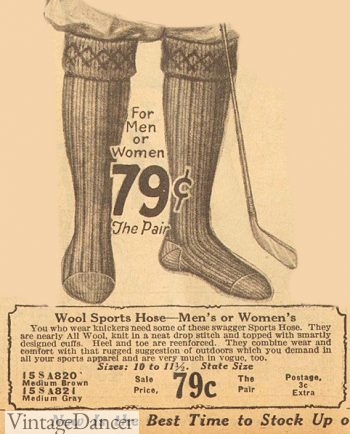
1926 Heavy Sport Socks with Fold Over Cuff in Brown or Grey
Color combinations and patterns were drawn from the futuristic school of art: diamonds (argyle), criss-cross, circular stripes, checks, and plaids. Look here for tall argyle golf socks.
- 1925 Socks
- 1928 Socks
- 1929 Socks
- 1929 Socks
Away from sports and back to business, 1920s men often coordinated the color of their socks to their suits, ties, and pocket squares. Rayon now mixed with cotton lisle in shades of grey, sand, camel, dark brown, black, and navy blue. Fancy versions had small patterns of diamonds, stripes, clocking, and checks. Fancy socks showed off the new low cut Oxford shoes popular in the 1920s.
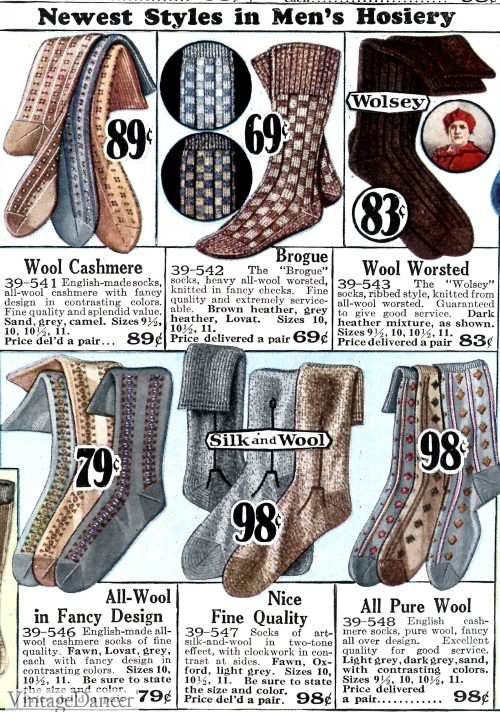
1928 Men’s Fancy Dress Socks
Working class men still wore plain socks in brown, blue, or black with white or cream toes and heels. Sport socks for golf, hiking, hunting, and other outdoor recreations still came in classic fold-over cuff styles worn with knickers tucked in. You can still see this style worn with Scottish kilts or traditional English shooting games.
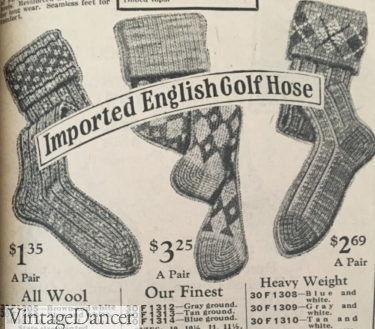
Golf Socks
It also became particularly popular for men to match their sock garters with their suspenders – not that anybody would see them, as these were two items hidden from plain sight.
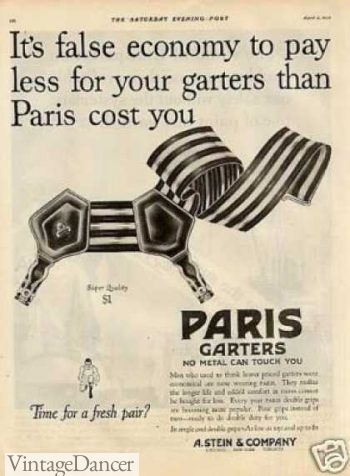
1920s Striped Elastic Sock Garters
In 1929, in the same year as the financial crisis that became known as the Wall Street Crash, socks started to become stretchy with Lastex introduced to men’s hosiery. This was a major development in the history of socks, as elasticized socks would eventually result in men discarding their sock garters completely.
History of Vintage Socks: Flamboyant 1930s
During the 1930s, socks continued to become more bold outside of the sportsfield, available in colorful stripes, Art Deco patterns, and argyle designs. New designs favored the Glen check and Glen plaid to match patterns found in suits and shirts.

1932 Sock Patterns Similar to the 1920s
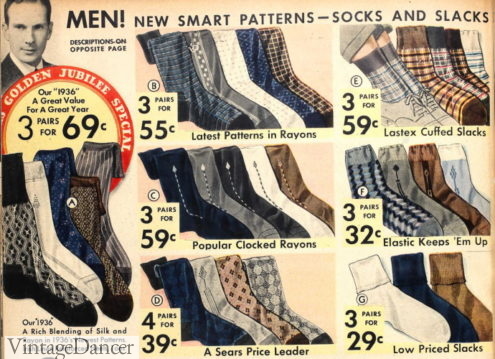
1936 Men’s Socks
Stripes and checks were the most common, mirroring suit fabrics. However, it was no longer expected to match socks to the suit. It was perfectly normal to wear bright red, lavender, or blue socks with your grey business suit! The influence of casual fashion affected everyone in whatever ways it could.
- 1936 dress socks
- 1938 dress or casual socks
- 1939 pattern socks
In summer, shorter ankle socks in white or pastel colors were seen with shorts and canvas crepe sole shoes. In winter, heavy wool socks mimicked tweed, cheviot, and Shetland fabrics. But it was the argyle pattern that ruled young men’s and fashion forward older men’s attire. Novelty textures such as crochet weaves, herringbone, horizontal stripes, and a bouclé effect added greater diversity to the already flamboyant patterns and colors.
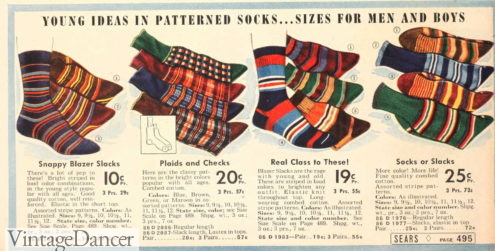
1939 New Stripe Patterned Socks for Men and Boys
Vintage Men’s Socks: Fabulous 1940s
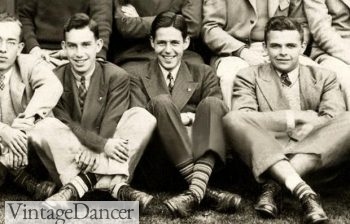
1940 Young Men’s Striped Socks
During the war years, wool shortages and wartime restrictions meant that people now started to knit socks using cotton and other fibers that were more freely available. Manufacturers had to work with the new synthetic, Nylon, when natural fibers ran short. It also led to socks shrinking in length to above the ankle, rather than over the calf (OTC).
- 1940 Men’s Socks
- 1942 Men’s Socks
Vintage Nylon socks are highly collectible today (preferably new, deadstock, and un-worn). Men’s vintage patterned nylon socks are the most sought after despite a plethora of new vintage style socks on the market today. There is nothing quite like genuine vintage!
- 1941 Men’s Socks
- 1943 Men’s Socks
The elastic in socks began to improve, with sock companies boasting of this in their publicity. Sock garters were needed less and less, although they were still sold into the 1950s.
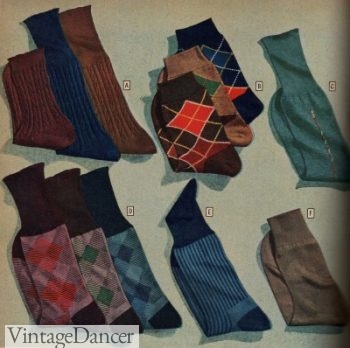
1944 Men’s Dress Socks in Solid, Striped, Clock, and Argyle Patterns
Fancy dress socks accounted for 60% of men’s sock sales, with only 40% being plain colors by the end of the 1940s. Silk socks were almost non-existent as nylon continued to improve and remain affordable.
- 1941 men’s dress socks
- 1948 men’s argyle Rayon socks
This was a time where young men continued to experiment with their hosiery options, from colorful argyle to athletic socks made from cotton. Socks with bands of color or white ribbing at the top was also a popular style.
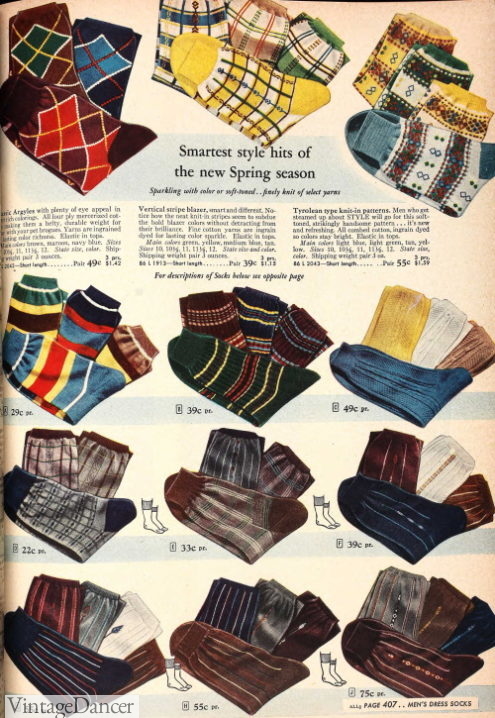
1948 Patterned Sport Socks and Dress Socks
1950s Vintage Men’s Socks: Bold was Back
After the war and in the decades that followed, the shorter socks and use of fabrics remained. Almost any color combination was seen on men’s ankles, including pink and purple.
- 1951 Men’s Socks
- 1952 Men’s Socks
Initially, the early 1950s were a conservative look for men, and socks reflected this with the classic business colors, grey, black, and navy blue in vertically-oriented small argyle and diamond patterns. Patterns that created long lines were thought to help men look leaner, too. Socks that bunched at the ankle did not aid the lean look, so once again sock garters were worn to hold them up.
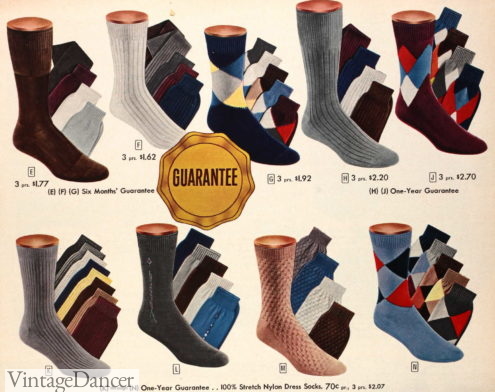
1957 Ribbed, Argyle, Clocked Dress Socks
Beyond the conservative business look, leisure clothing returned to colors and pattern seen in the 1930s. A plain colored sock was topped with colorful argyles (teal, black, yellow, red, sky blue, orange). Pastels were also popular in summer in peach, yellow, sage green, and oatmeal.
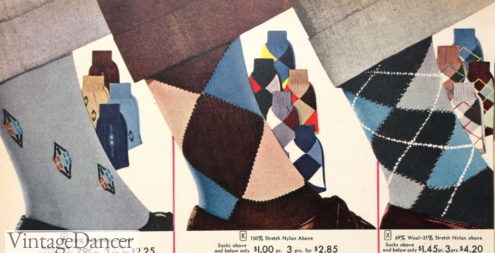
1956 Clocked and Argyle Socks
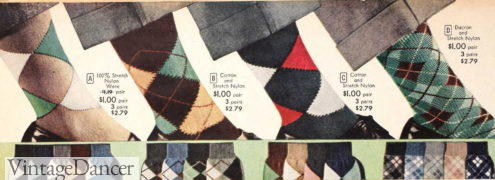
1956 Argyle Socks
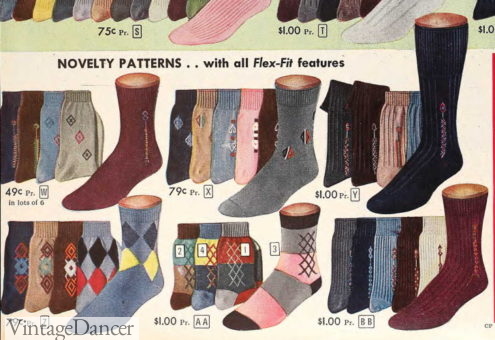
1955 Patterned Socks (Pink!)
Most dress and sport socks continued to be ankle length. There was a renewed interest in taller over-the-calf socks in big argyles or plain ribbed with a fold over cuff, just like they were in the 1920s. These were worn with summer shorts and loafers.
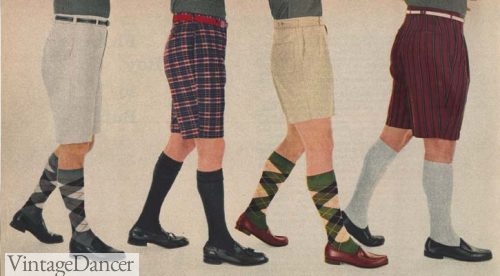
1956 Men’s Tall Socks – Argyle and Plain Rib with Cuffs
1960s Vintage Men’s Socks: Dull and Gone
You would think with the mid century mod style disrupting the 1960s that vintage men’s socks would take a drastic change, just like women’s and men’s clothing did. Sadly, it went the opposite way into a mild, modest, and dare I say boring direction. Large all-over prints were reduced down to a small cluster of diamonds on the ankle only, although some designs did look a little mod art-esque. Colors returned to the safe zone of grey, blue, tan and navy for business dress.
- 1964 Men’s Dress Socks
- 1963 Men’s Dress Socks
Sport socks retained some vivid colors such as red, green and white. White socks were actually a new color. They looked modern and new. No one was afraid of getting white socks dirty with easy-to-clean synthetic materials (Orlon, Dacron) and better washing detergents. Improvements to elasticity made the shortest sock (so far) the crew, a viable sport sock. They came in every shade imaginable.
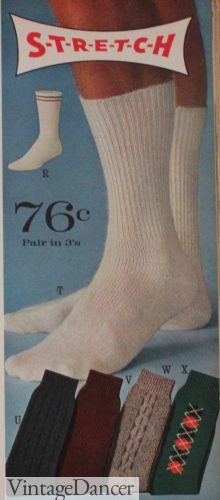
1964, The White Sport Sock is Introduced
- 1965 Boring Dress Socks
- 1968 Matching Socks to Shirts – Very Mod!
Among the fashion forward, new patterns in socks were repeated checks and windowpane, last seen in the 1920s. These large prints highlighted shiny patent leather Oxfords, buckle monks, and multi-tone brogues. Of course, it wasn’t long before certain young men thought that all socks were “too old” and ditched them altogether. The no sock look, worn with boat shoes and loafers, terrified the sock industry.
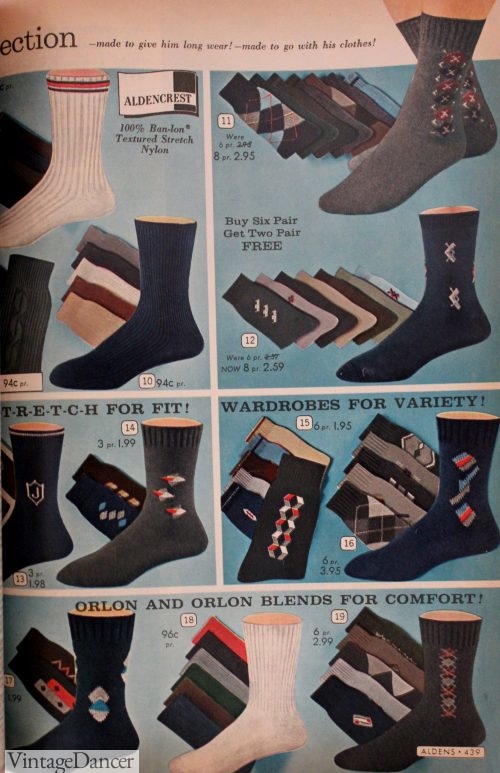
1967 Sport Socks and Dress Socks
Socks Today
Today, I like to have fun with my hosiery like the men of yesterday seemed to do. I believe that socks offer men a chance to really experiment with color and be a little braver in their personal style choices. On occasion, I even wear sock garters. They keep my socks perfectly in place, and the look of an unwrinkled sock is always better — especially as shorter length socks can occasionally slip down and bunch up at the heel.
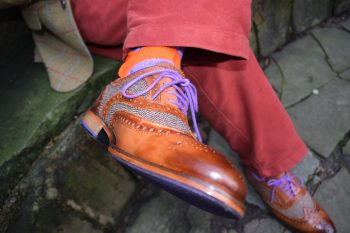
There are some truly exquisite socks still available today. If you have a black tie function coming up, do try some dark silk dress socks. They are lighter and finer and just feel fantastic. Cotton is cooler, so it’s best for summer months and of course, wool will keep you warm in winter. If you’re searching for a good everyday sock though, then I would recommend Merino wool.
A word of warning, though — please do beware the danger of novelty socks. I can assure you that the novelty will wear off faster than the holes begin appearing.
Traditional reproduction men’s socks can be found a Simon James Cathcart.
~ Gary
Read More
- Men’s 1920s Shoes History
- A History of Men’s Ties, 1920s-1970s
- History of Men’s Cufflinks, Rings, Collar Bars, and Jewelry
- 1900s-1960s Men’s Watches and Timepieces
Debbie Sessions has been teaching fashion history and helping people dress for vintage themed events since 2009. She has turned a hobby into VintageDancer.com with hundreds of well researched articles and hand picked links to vintage inspired clothing online. She aims to make dressing accurately (or not) an affordable option for all. Oh, and she dances too.
